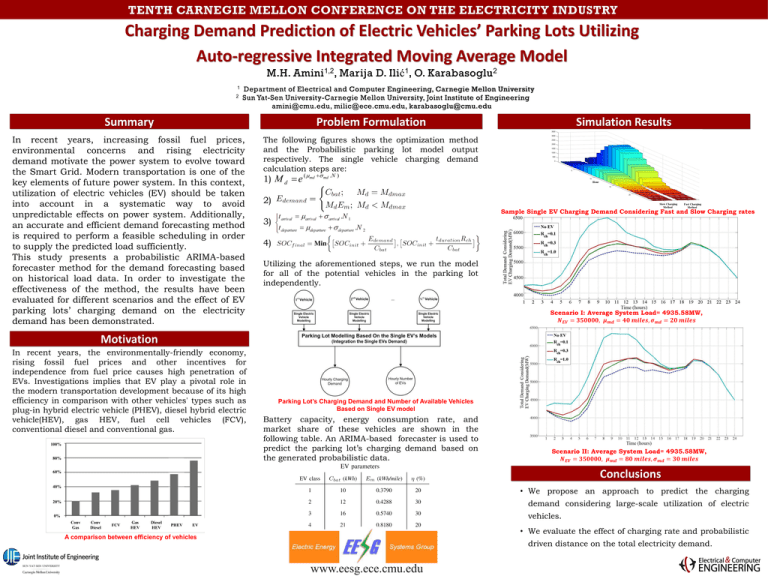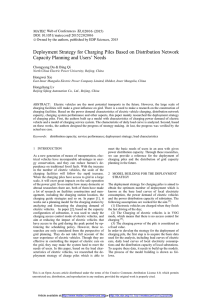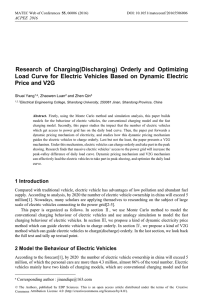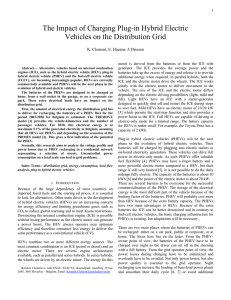Charging Demand Prediction of Electric Vehicles’ Parking Lots Utilizing
advertisement

Charging Demand Prediction of Electric Vehicles’ Parking Lots Utilizing Auto-regressive Integrated Moving Average Model M.H. Amini 1,2, Marija D. Ilić 1, O. Karabasoglu 2 1 2 Department of Electrical and Computer Engineering, Carnegie Mellon University Sun Yat-Sen University-Carnegie Mellon University, Joint Institute of Engineering amini@cmu.edu, milic@ece.cmu.edu, karabasoglu@cmu.edu Summary Problem Formulation In recent years, increasing fossil fuel prices, environmental concerns and rising electricity demand motivate the power system to evolve toward the Smart Grid. Modern transportation is one of the key elements of future power system. In this context, utilization of electric vehicles (EV) should be taken into account in a systematic way to avoid unpredictable effects on power system. Additionally, an accurate and efficient demand forecasting method is required to perform a feasible scheduling in order to supply the predicted load sufficiently. This study presents a probabilistic ARIMA-based forecaster method for the demand forecasting based on historical load data. In order to investigate the effectiveness of the method, the results have been evaluated for different scenarios and the effect of EV parking lots’ charging demand on the electricity demand has been demonstrated. The following figures shows the optimization method and the Probabilistic parking lot model output respectively. The single vehicle charging demand calculation steps are: 1) M d e Simulation Results ( md md .N ) 2) Sample Single EV Charging Demand Considering Fast and Slow Charging rates 3) 4) Utilizing the aforementioned steps, we run the model for all of the potential vehicles in the parking lot independently. Scenario I: Average System Load= 4935.58MW, 𝑵𝑬𝑽 = 𝟑𝟓𝟎𝟎𝟎𝟎, 𝝁𝒎𝒅 = 𝟒𝟎 𝒎𝒊𝒍𝒆𝒔, 𝝈𝒎𝒅 = 𝟐𝟎 𝒎𝒊𝒍𝒆𝒔 Motivation In recent years, the environmentally-friendly economy, rising fossil fuel prices and other incentives for independence from fuel price causes high penetration of EVs. Investigations implies that EV play a pivotal role in the modern transportation development because of its high efficiency in comparison with other vehicles' types such as plug-in hybrid electric vehicle (PHEV), diesel hybrid electric vehicle(HEV), gas HEV, fuel cell vehicles (FCV), conventional diesel and conventional gas. 100% 80% Parking Lot’s Charging Demand and Number of Available Vehicles Based on Single EV model Battery capacity, energy consumption rate, and market share of these vehicles are shown in the following table. An ARIMA-based forecaster is used to predict the parking lot’s charging demand based on the generated probabilistic data. Scenario II: Average System Load= 4935.58MW, 𝑵𝑬𝑽 = 𝟑𝟓𝟎𝟎𝟎𝟎, 𝝁𝒎𝒅 = 𝟖𝟎 𝒎𝒊𝒍𝒆𝒔, 𝝈𝒎𝒅 = 𝟑𝟎 𝒎𝒊𝒍𝒆𝒔 Conclusions 60% 40% • We propose an approach to predict the charging 20% demand considering large-scale utilization of electric 0% vehicles. Conv Gas Conv Diesel FCV Gas HEV Diesel HEV PHEV EV • We evaluate the effect of charging rate and probabilistic A comparison between efficiency of vehicles driven distance on the total electricity demand. www.eesg.ece.cmu.edu











